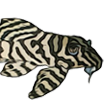Pereira, LHG, F Foresti & C Oliveira, 2009. Genetic structure of the migratory catfish Pseudoplatystoma corruscans (Siluriformes: Pimelodidae) suggests homing behaviour. Ecology of Freshwater Fish 18: 215–225.
Abstract
Pseudoplatystoma corruscans is distributed widely in the La Plata Basin in Brazil, where it is a very important species because of its high commercial value and ecological role as a voracious predator. This species undertakes long migrations during the dry and rainy seasons to feed and reproduce, respectively. In this study, we analysed seven microsatellite loci to test the hypotheses of the existence of a single panmictic population of P. corruscans in the La Plata Basin. All microsatellites analysed were highly polymorphic with the number of alleles per locus ranging from seven (Pcor28) to 30 (Pcor10). Across all samples, 107 alleles were detected. Thirty alleles were private, i.e., found in only one sample. Highly significant genetic differentiation was observed among samples in three of the four analyses performed: FST (from 0.03435 to 0.16349, P < 0.05), Analysis of molecular variance (amova)FST = 8.25% (P < 0.0001) and amovaRST = 9.72% (P < 0.0001). A microsatellite multilocus Bayesian assignment test with the programme structure confirmed the division of the fishes into six groups largely concurrent with main branches on a population neighbour-joining tree. The obtained results rejected the panmixia hypothesis. On the other hand, the documented long-distance movements of P. corruscans and the geographical scale of genetic differentiation found in this study indicate a strong tendency for fish of this species to utilise their natal nursery regions for reproduction, which represents the first demonstrated example of homing in a freshwater catfish in South America.
Homing behavior in Pseudoplatystoma
- Silurus
- Posts: 12420
- Joined: 31 Dec 2002, 11:35
- I've donated: $12.00!
- My articles: 55
- My images: 893
- My catfish: 1
- My cats species list: 90 (i:1, k:0)
- Spotted: 424
- Location 1: Singapore
- Location 2: Moderator Emeritus





